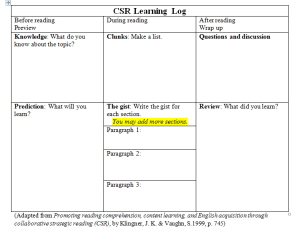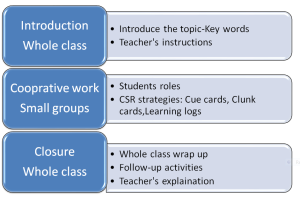Collaborative Strategic Reading (CSR): A Comprehension Strategy to Enhance Content Area Learning
Collaborative Strategic Reading (CSR) is a research-based instructional practice in teaching reading comprehension to students to enhance content area learning. CSR teaches students reading comprehension while working in small cooperative groups. It is mostly used with expository text, but can also be used with narrative text. CSR consists of four reading comprehension strategies that are applied before, during, and after reading. CSR strategies are: (1) preview the text, (2) click and clunk, (3) get the gist, and (4) wrap up. In this article, I will describe the CSR instructional approaches: reading comprehension strategies and cooperative learning groups.
Before reading:
Preview the text
Students preview the whole passage before reading its sections. Previewing the text activates prior knowledge, stimulates students’ interest about the topic, and facilitates making predictions. During this step, students look at headings, key words, pictures, and charts in a short period of time. The teacher asks students some questions to engage them in a classroom discussion about what they learned from the previews. Also, the teacher encourages students to predict what they think they will learn from reading.
During reading:
Click and clunk (I get it - I do not get it)
Students monitor their understanding and decide if they really understand what they read or not during reading. When students read a passage with understanding, they proceed smoothly through the text. When students find a word, concept, or idea hard to understand, it is a clunk. Clunks break down reading comprehension and make it hard to understand the whole text. In this case, students need to identify the clunks then figure them out using fix- up strategies, written on clunk cards, to understand the text.
Fix-up strategies may include but are not limited to:
- Vocabulary fix-up skills: The student rereads the sentence and looks for clues to understand the meaning of the unknown vocabulary word in the sentence. Also, breaking up the word into its syllables or prefix and suffix to look for smaller words.
- Read-Pause-Reflect: To help students monitor their understanding during reading, allow them to decide to pause at any point to recall the main ideas for each part. If a student does not understand the topic, he/she rereads the section.
- Partner Retell: Students work in pairs in this activity. One student assigned the role of “re-teller” and the other assigned the role of “listener”. The reteller talks about the main idea(s), concepts, and points of the reading while the other student listens, comments, and ask questions. Then, the teacher randomly calls one of the listeners to share information told by the reteller.
Get the gist
Students learn to identify the most important idea(s) in the text during reading. This strategy teaches students to use their own words to explain the main ideas of every paragraph or two using a few words to check for understanding.
After reading:
Wrapping up
After reading, students identify the most important ideas from the entire section they have read. They generate questions and answers about the information in the text. Encourage students to create high order thinking questions and write down the most important information in the text.
CSR learning logs
Students track their understanding during the CSR process by using learning logs. Students complete learning logs before, during, and after reading. CSR learning logs used as a reference for follow-up activities, a study guide, and for evaluation.

Follow-up Activities- Not limited to:
Follow-up activities are used to reinforce the main ideas and the vocabulary words students have learned from reading.
- Verbal and Visual-Word Association: Students write clunks on a Post-it note and adhere it to the page in which the chunks were found. Then, they draw a rectangle divided into four sections for each word. Students complete the boxes by providing the definition and a visual representation of the word, and their personal association to the word.
- Cubing: Students compose a descriptive paragraph using a cube. On each side of the cube the following will be written: (a) describe it, (b) compare it, (c) associate it, (d) analyze it, (e) apply it, (f) and argue for or against it.
- Graphic Organizers: Students organize the information they have learned from reading in charts, diagrams, or maps. For example, one group uses a Venn - diagram to compare and contrast ideas. Another group uses semantic mapping to show the relationship among ideas.
- Fishbowl: Each group writes one question or two about the topic they read. Students leave the question(s) on their table for other groups to answer. Under the supervision of the teacher, students will rotate and answer the questions.
Cooperative Groups
Students work in small cooperative groups to apply CSR strategies. Thus, they will be assigned roles to perform while using CSR strategies. Teachers train their students to apply the four comprehension strategies of CSR through modeling and classroom activities from the beginning of the year. Students may use cue cards to remind them about the strategies and their roles. When they feel confident implementing CSR strategies and roles, they may stop using cue cards.
Student roles
Once students have developed the CSR strategy demonstration skills and understand their roles, they are ready to apply CSR strategies in cooperative groups. The teacher assigns each student a role in his/her group. Roles depend on the number of students in the groups. Possible roles are:
- Leader: Leads and directs the group during the implementation of CSR with the teacher’s assistance, if needed, and keeps the group’s members on task.
- Clunk expert: Uses clunk cards to show the group the fix-up strategies when they try to figure out a clunk.
- Gist Expert: Guides the group to identify the most important ideas of the passage they are reading.
- Encourager: Encourages the group members participate in the group’s discussion and gives the feedback.
- Announcer: Calls on the group members to read or share ideas during the activity.
- Reporter: Share the group’s ideas, answers, and questions during a whole class discussion.
Teachers Roles
The teacher presents and teaches students the CSR strategy and cooperative grouping from the beginning of the year. When students develop the skills and implement CSR strategies in cooperative groups, the teacher should circulate among the groups to facilitate cooperative learning, provide assistance and support when needed, and clarify any misconceptions.
Process
The diagram below shows the basic steps of CSR:

Final Thoughts
Although CSR was developed to help students with learning disabilities and limited English proficient students, CSR has positively impacted the standardized reading comprehension tests scores for average and high average achieving students (Klingner & Vaughn, 1999). CSR improves reading comprehension, develops cooperative skills, and enhances students overall performance and achievement in any subject.
References
Klingner J. & Vaughn S. (1999). Promoting reading comprehension, content learning, and English acquisition through collaborative strategic reading (CSR). The Reading Teacher, 52. No. 7
Bean, T.W., Readence, J.E., & Baldwin, R.S. (2011). Content area literacy: An integrated approach, (10th ed.). Dubuque, Iowa: Kendall/Hunt.
Reading Comprehension Fix-Up Skills: A Classroom Toolkit. (n.d.). Retrieved on April 15, 2015.